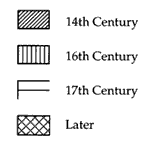| THE
EARLY CASTLE
Mugdock Castle was an important seat
of one of Scotland's most prominent noble families, the
Grahams, from the 13th century until 1945. Sir David de
Grahame, one of the early owners of Mugdock lands, was a
contemporary of Robert the Bruce and lived during one of
Scotland's great struggles against English overlordship.
His support for the Scottish cause is well illustrated by
his much quoted oath "as long as but a hundred of us
remain alive never will we on any condition be brought under
English rule". The first stone castle at Mugdock was
most probably built by his son around 1372.
 
This early castle was built around a four
sided courtyard. It's four towers did not project beyond
the tall curtain walls giving it a less threatening appearance
than other castles of it's day. So what remains of the first
castle? Parts of the North West tower, portcullis and curtain
wall can still be seen but the South West tower has survived
best of all and is being carefully restored. It's ground
floor was originally a prison and the rooms above first
rate suites probably occupied by the owner. From the parapet
walk on top of the tower watchmen could view the entire
Clyde Valley to the South and the first risings of the Campsies
to the North.
THE 15th CENTURY GRAHAMS
The 'Gallant Grahams' continued to
be brave and loyal supporters of the Scottish throne. They
were well rewarded in 1458 when their Stirlingshire lands
became the Barony of Mugdock making the castle the centre
of power for miles around. Lord Graham, or the Earl of Montrose
as his descendants knew him, had several residences and
moved frequently between them. Whilst living at Mugdock
he would hold court at the castle, oversee his lands and
prepare for war.
During these J
times the castle and it's surrounds changed considerably.
A new, larger courtyard was created by building a lower
wall around the castle and it's surrounding grounds. The
wall was pierced by keyhole-shaped gun loops contrasting
strongly with the arrow slits of the castle and curtain
walls. Look closely and you can see the holes which reflect
the weapons in use at the time of building. New buildings
were erected within the courtyard including a domestic range
attached to the SW tower. The ruin of this building can
still be seen today.
THE GREAT MARQUIS
The most famous Graham to live at Mugdock
was James, Fifth Earl and first Marquis of Montrose (1612
- 1650). Known as the great Marquis, he was a fine soldier
and led the Covenanters against Charles I. However, he gradually
became disillusioned with the leaders of the Covenant and
took up the cause of the English King, fighting against
his old arch-rival, the Marquis of Argyll. In 1650 Montrose
was betrayed. He was taken prisoner and hung, drawn and
quartered at Edinburgh Cross. His remains were displayed
in the main Scottish towns as an example.
Mugdock Castle suffered during these
times. It was heavily ransacked and fell into Argyll's hands
for a few years, being reclaimed by the Great Marquis, heir
in 1655. His father's expensive adventures left the 'Good
Marquis' without money. He sold land to rebuild Mugdock
but it was always considered a "poor dwelling for a
Marquis" from then on.
TO THE PRESENT DAY
By 1680 the 3rd Marquis had moved to
the grander Buchanan Castle, and until 1836 Mugdock was
home to another branch of the Graham family. The walled
garden and summerhouse were added by the last Graham residents,
three unmarried sisters, around 1820.
Mugdock's next resident was Archibald
McLellan, the founder of the McLellan Gallery. He leased
Mugdock as a country house and died there in 1854 in the
company of his mistress. In 1874 the last house was built
at Mugdock. John Guthrie-Smith, the antiquarian, demolished
most of the existing buildings and linked his new Scots-baronial
mansion to the original South West tower which he used as
a smoking room.
The house and Mugdock Estate were sold
to Sir Hugh Fraser after World War II and subsequently gifted
to Central Regional Council for development as a country
park in 1981.
|



